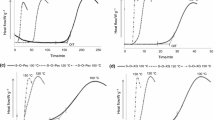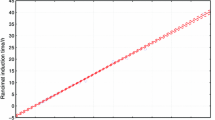Abstract
A study on the thermal stability and kinetic parameters of an Octol formulation stockpiled for prolonged period a 20 year under natural environment conditions was investigated. The thermal stability of the naturally aged was studied by an employing thermogravimetry and differential scanning calorimetry methods and compared with freshly prepared Octol formulation. The results showed that the thermal stability did not significantly vary for aged Octol samples. The kinetic parameters of aged and freshly prepared Octol samples were also studied by means of the Kissinger and isoconversional Kissinger–Akahira–Sunose (KAS) methods. The values of apparent activation energy derived from the Kissinger method using DSC data for aged and fresh samples were obtained around 228.8 and 234.4 kJ mol‒1, respectively. The isoconversional KAS method was also used for computation of the activation energy at different values of conversion for two stages of thermal degradation using TGA data. The determined average activation energy for the first stage was obtained around 88.9 ± 4.1 kJ mol−1 for aged and 94.6 ± 6.5 kJ mol−1 for fresh sample, while average activation energy for the second stage was obtained 212.7 ± 14.5 kJ mol−1 and 218 ± 14 kJ mol‒1 for aged and fresh Octol formulations, respectively. These values were found to be consistent and close to those obtained from the Kissinger method. These results indicated that there was no any significant change in the kinetic parameters for aged and fresh samples. The pre-exponential factor for different values of conversion was also determined by the use of the so-called compensation effect. Conversion of aged and fresh samples using the kinetic parameters was found to be in good agreement with the experimental conversion data, and the maximum error limit was observed to be 8.0% between experimental and predicted conversion.











Similar content being viewed by others
References
Akhavan J. The chemistry of explosives. 2nd ed. Swindon: Cranfield University Press; 2004. p. 37–9.
Luo L, Guo P, Jin B, Xiao Y, Zhang Q, Chu S, Peng R. An isothermal decomposition dynamics research instrument and its application in HMX/TNT/Al composite explosive. J Therm Anal Calorim. 2020;139:2265–72.
Vuono CE. Military explosives. Washington, D.C.: Department of the Army Technical Manual; 1990.
Urbanski T. Chemistry and technology of explosives, vol. 1. Oxford: Pergamon Press; 1964. p. 290–300.
Anderson E. Explosives tactical missile warheads, Edited by J. Carleone, Volume 155, Progress in Astronautics and Aeronautic (A volume in the AIAA Tactical Missile Series), 1993, pp. 90–91, ISSN 0079-6050.
Fung P, Ackerman J, McEwan J, Dolch T, Wiegand, D. Ammunition stockpile reliability, TNT aging investigative study. TACOM-ARDEC Report No. AMSTA-AR-QAT-01-98, 1998.
Wei R, Huang S, Wang Z, Wang X, Ding C, Yuen R, Wang J. Thermal behavior of nitrocellulose with different aging periods. J Therm Anal Calorim. 2019;136:651–60.
Wiegand D, Pinto J, Nicolaides S. The mechanical response of TNT and a composite, Composition B, of TNT and RDX to compressive stress: I uniaxial stress and fracture. J Energetic Mater. 1991;9:19–80.
Wiegand D, Pinto J. The Mechanical Response of TNT and a composite, Composition B, of TNT and RDX to compressive stress: III Dependence on processing and composition. J Energetic Mater. 1991;9:349–413.
Zohari N, Abrishami F, Zeynali V. Prediction of decomposition temperature of azole-based energetic compounds in order to assess of their thermal stability. J Therm Anal Calorim. 2019. https://doi.org/10.1007/s10973-019-09127-2.
Wei C, Lin W, Pan X, et al. Thermal risk assessment of tert-butylperoxy-2-ethylhexyl carbonate for storage and transport. J Therm Anal Calorim. 2019;138:2891–900.
Lu Y, Liu S, Shu C. Evaluation of thermal hazards based on thermokinetic parameters of 2-(1-cyano-1-methylethyl)azocarboxamide by ARC and DSC. J Therm Anal Calorim. 2019;138:2873–81.
Singh A, Kumar M, Soni PK, Singh M, Srivastava A. Mechanical and explosive properties of plastic bonded explosives based on mixture of HMX and TATB. Def Sci J. 2013;63:622–9.
Wang J, Chen S, Jin S, Shu Q, Zhang X, Shi R. Thermal behavior, compatibility study and safety assessment of diammonium 5,5′-bistetrazole-1,1′-diolate (ABTOX). Therm Anal Calorim. 2020;139:1771–7.
Zhou S, Zhou X, Tang G, Guo X, Pang A. Differences of thermal decomposition behaviors and combustion properties between CL-20-based propellants and HMX-based solid propellants. J Therm Anal Calorim. 2019. https://doi.org/10.1007/s10973-019-09004-y.
Singh A, Kumar R, Soni PK, Singh V. Compatibility and thermal decomposition kinetics between HMX and some polyester-based polyurethanes. J Therm Anal Calorim. 2020. https://doi.org/10.1007/s10973-020-09377-5.
Pouretedal HR, Damiri S, Sharifi A. Study of triplet kinetic of thermal decomposition reaction and sensitivity to impact and electrostatic discharge of HMX polymorphs. J Therm Anal Calorim. 2020;139:545–53.
Singh A, Kaur G, Sarkar C, Mukherjee N. Investigations on chemical, thermal decomposition behavior, kinetics, reaction mechanism and thermodynamic properties of aged TATB. Cent Eur J Energetic Mater. 2018;15(2):258–82.
Singh A, Sharma TC, Singh V, Mukherjee N. Thermal degradation behaviour and kinetics of aged TNT-based melt cast Composition B. Cent Eur J Energetic Mater. 2019;16(3):360–79.
Brill TB, James KJ. Thermal decomposition of energetic materials. 62. Reconciliation of the kinetics and mechanisms of TNT on the time scale from microseconds to hours. J Phys Chem. 1993;97:8759–63.
Rom N, Hirshberg B, Zeiri Y, Furman D, Zybin SV, Goddard WA, Kosloff R. First-principles-based reaction kinetics for decomposition of hot, dense liquid TNT from Reax FF multiscale reactive dynamics simulations. J Phys Chem C. 2013;117:21043–54.
Guidry RM, Davis LP. Thermochemical decomposition of explosives. I. TNT kinetic parameters determined from ESR investigations. Thermochim Acta. 1979;32:1–18.
Singh A, Soni PK, Shekharam T, Srivastava A. A Study on thermal behaviour of a poly(VDF-CTFE) copolymers binder for high energy materials. J Appl Polym Sci. 2013;127:1751–7.
Singh A, Sharma TC, Narang JK, Kishore P. Thermal decomposition and kinetics of plastic bonded explosives based on mixture of HMX and TATB with polymer matrices. Def Technol. 2017;13:22–32.
Singh A, Soni PK, Singh M, Srivastava A. Thermal degradation, kinetic and correlation models of poly(vinylidene-fluoride–chlorotrifluoroethylene) copolymers. Thermochim Acta. 2012;548:88–92.
Singh A, Singh S, Sharma TC, Kishore P. Physicochemical properties and kinetic analysis for some fluoropolymers by differential scanning calorimetry. Polym Bull. 2018;75:2315–38.
Singh A, Soni PK, Sarkar C, Mukherjee N. Thermal reactivity of aluminized polymer-bonded explosives based on non-isothermal thermogravimetry and calorimetry measurements. J Therm Anal Calorim. 2019;136:1021–35.
Singh A, Kumar R, Soni PK, Singh V. Compatibility and thermokinetics studies of octahydro-1,3,5,7-tetranitro-1,3,5,7-tetrazocine with polyether-based polyurethane containing different curatives. J Energetic Mater. 2019;37:141–53.
Singh A, Singla P, Sahoo SC, Soni PK. Compatibility and thermal decomposition behavior of an epoxy resin with some energetic compounds. J Energetic Mater. 2020. https://doi.org/10.1080/07370652.2020.1727997.
Dubikhin FF, Matveev VG, Nazin GM. Thermal decomposition of 2,4,6-trinitrotoluene in melt and solutions. Russian Chem Bull. 1995;44:258–63.
Makashir PS, Kurian EM. Spectroscopic and thermal studies on 2,4,6-trinitrotoluene (TNT). J Therm Anal Calorim. 1999;55:173–85.
Ksiaczak A, Ksiczak T. Thermal decomposition of 2,4,6-trinitrotoluene during the induction period. Thermochim Acta. 1996;275:27–36.
Long GT, Brems BA, Wight CA. Autocatalytic thermal decomposition kinetics of TNT. Thermochim Acta. 2002;388:175–81.
Adler J. Thermal explosion theory with Arrhenius kinetics: media. London: Royal Society of London; 1991. p. 329–35.
Kissinger HE. Reaction kinetics in differential thermal analysis. J Therm Anal Chem. 1957;29:1702–6.
Vyazovkin S, Burnham AK, Criado JM, Perez-Maqueda LA, Popescu C, Sbirrazzuoli N. ICTAC kinetics committee recommendations for performing kinetic computations on thermal analysis data. Thermochim Acta. 2011;520:1–19.
Akahira T, Sunose T. Method of determining activation deterioration constant of electrical insulating materials. Res Rep CHIBA Inst Technol. 1971;16:22–31.
Pouretedal HR, Damiri S, Nosrati P, Ghaemi FE. The kinetic of mass loss of grades A and B of melted TNT by isothermal and non-isothermal gravimetric methods. Def Technol. 2017;12:126–31.
Brill TB, James KJ. Kinetics and mechanisms of thermal decomposition of nitroaromatic explosives. Chem Rev. 1993;93:2667–92.
Lee JS, Hsu CK, Chang CL. A study on the thermal decomposition behaviors of PETN, RDX, HNS and HMX. Thermochim Acta. 2002;392:173–6.
Brill TB, Gongwer PE, Williams GK. Thermal decomposition of energetic materials. 66. Kinetic compensation effects in HMX, RDX, and NTO. J Phys Chem. 1994;98:12242–7.
Sharia O, Tsyshevsky R, Kuklja MM. Surface-accelerated decomposition of δ-HMX. J Phys Chem Lett. 2013;4:730–4.
Pinheiro GFM, Lourenço VL, Iha K. influence of the heating rate in the thermal decomposition of HMX. J Therm Anal Calorim. 2002;67(445):452.
Chakraborty D, Muller RP, Dasgupta S, Goddard WA III. Mechanism for unimolecular decomposition of HMX (1,3,5,7-tetranitro-1,3,5,7-tetrazocine), an Ab Initio study. J Phys Chem A. 2001;105:1302–14.
Maksimov YY, Apolkova VN, Braverman OV, Solovev AI. Kinetics of the thermal decomposition of cyclotrimethylenetrinitramine and cyclotetramethylenetetranitramine in the gas phase. Russ J Phys Chem. 1985;59:201–4.
Burov YM, Nazin GM. Influence of structure on rate of decomposition of secondary nitramines in the gas phase. Kinet Catal. 1982;23:5–10.
Shaw R, Walker FE. Estimated kinetics and thermochemistry of some initial unimolecular reactions in the thermal decomposition of 1,3,5,7-tetranitro-1,3,5,7-tetraazacyclooctane in the gas phase. J Phys Chem. 1977;81:2572–6.
Acknowledgements
Authors express their thanks to Dr. Manjit Singh, Director, for his constant motivation, guidance and fruitful discussions. The authors are also thankful to Mr. Mahesh Kumar for his kind support for providing thermal analysis facility.
Author information
Authors and Affiliations
Corresponding author
Additional information
Publisher's Note
Springer Nature remains neutral with regard to jurisdictional claims in published maps and institutional affiliations.
Rights and permissions
About this article
Cite this article
Singh, A., Sharma, T.C., Singh, V. et al. Studies on the thermal stability and kinetic parameters of naturally aged Octol formulation. J Therm Anal Calorim 145, 411–421 (2021). https://doi.org/10.1007/s10973-020-09750-4
Received:
Accepted:
Published:
Issue Date:
DOI: https://doi.org/10.1007/s10973-020-09750-4




